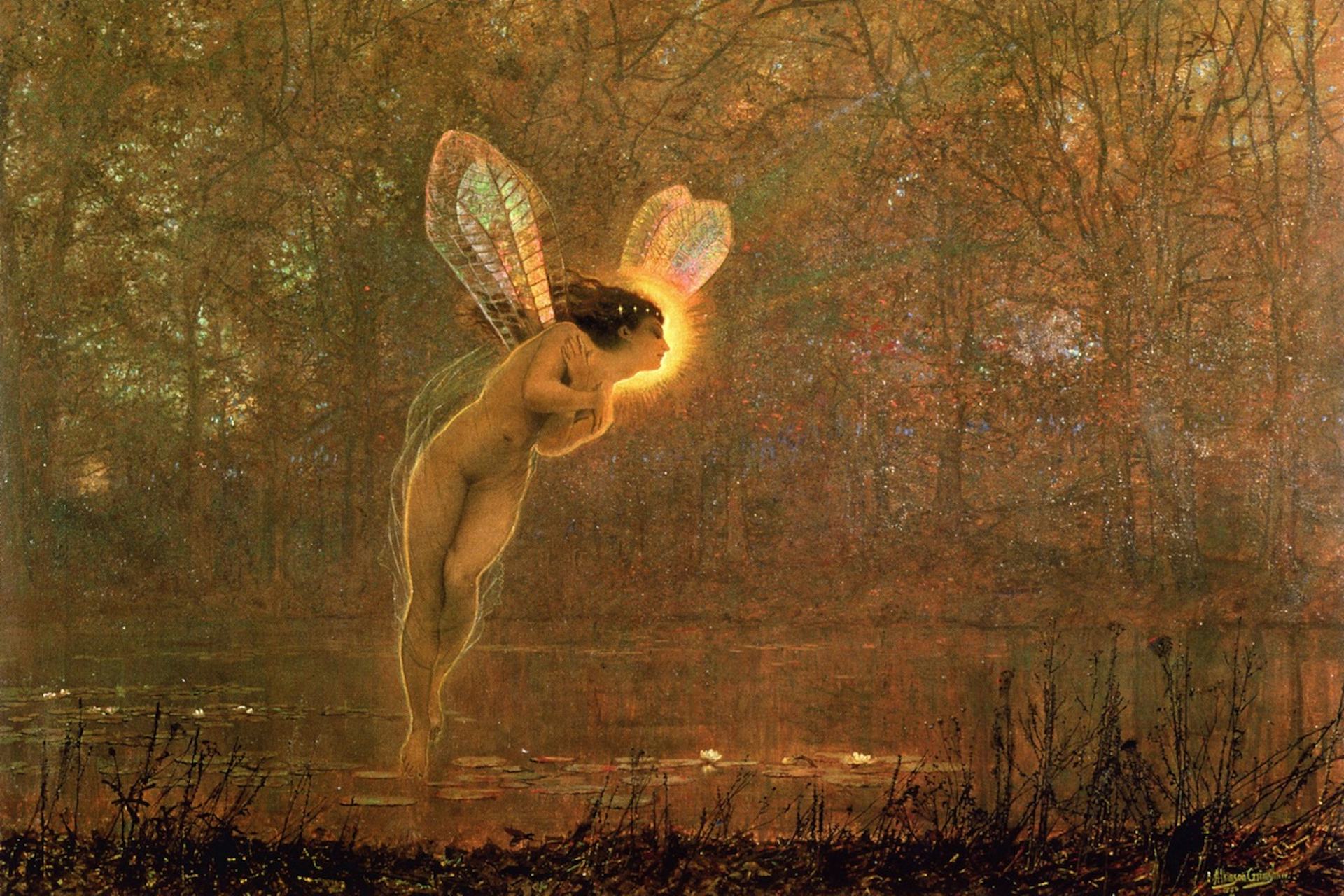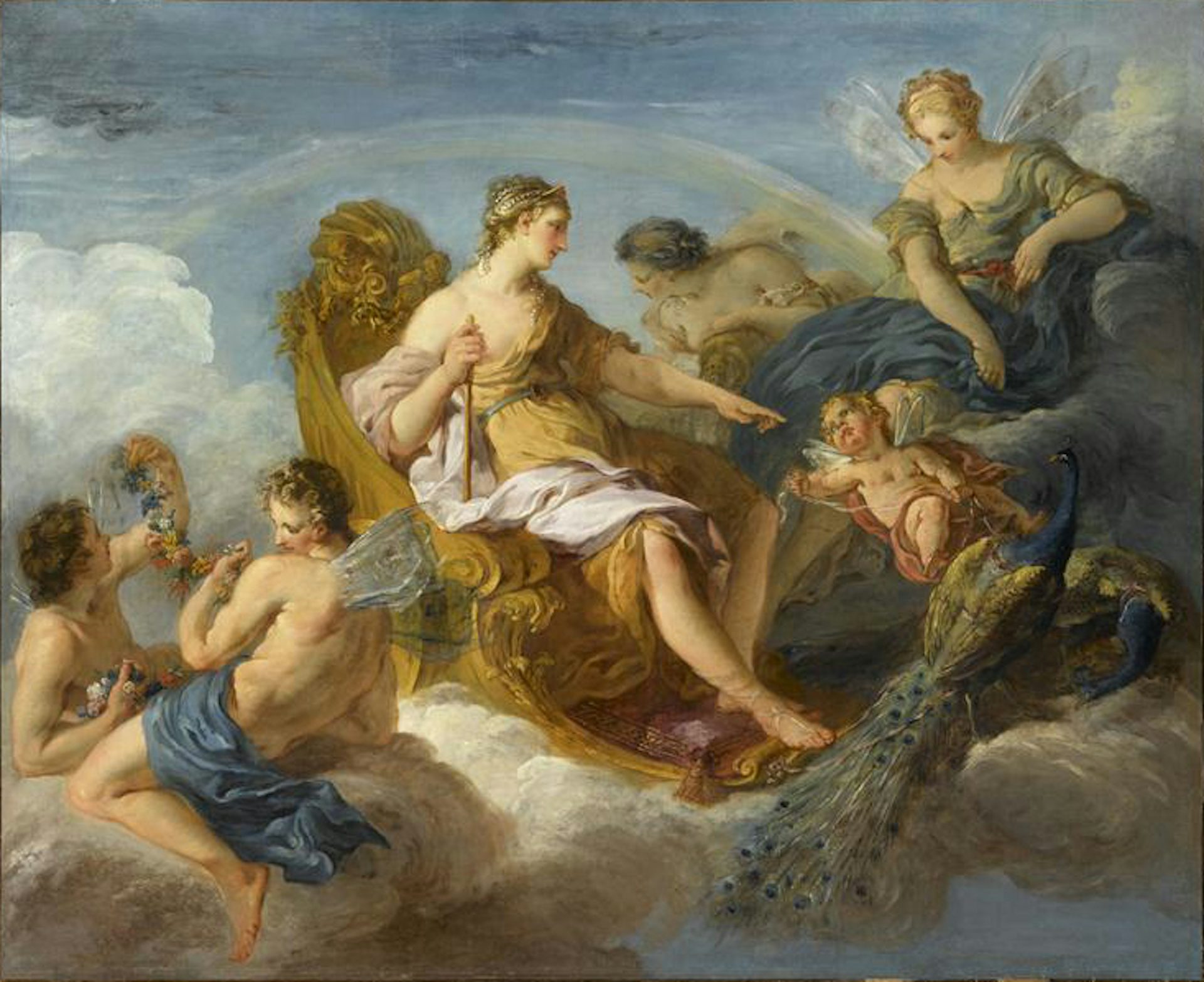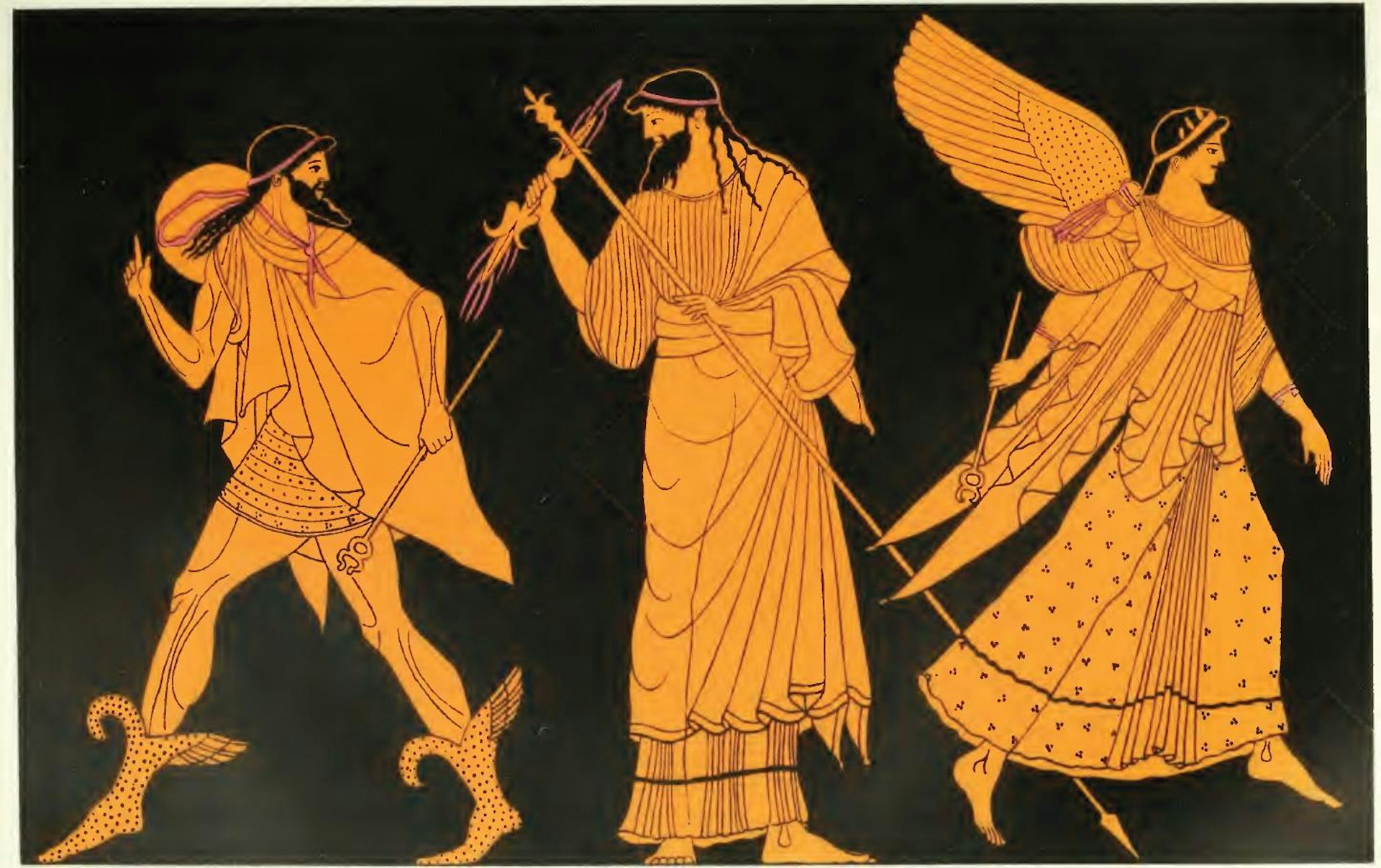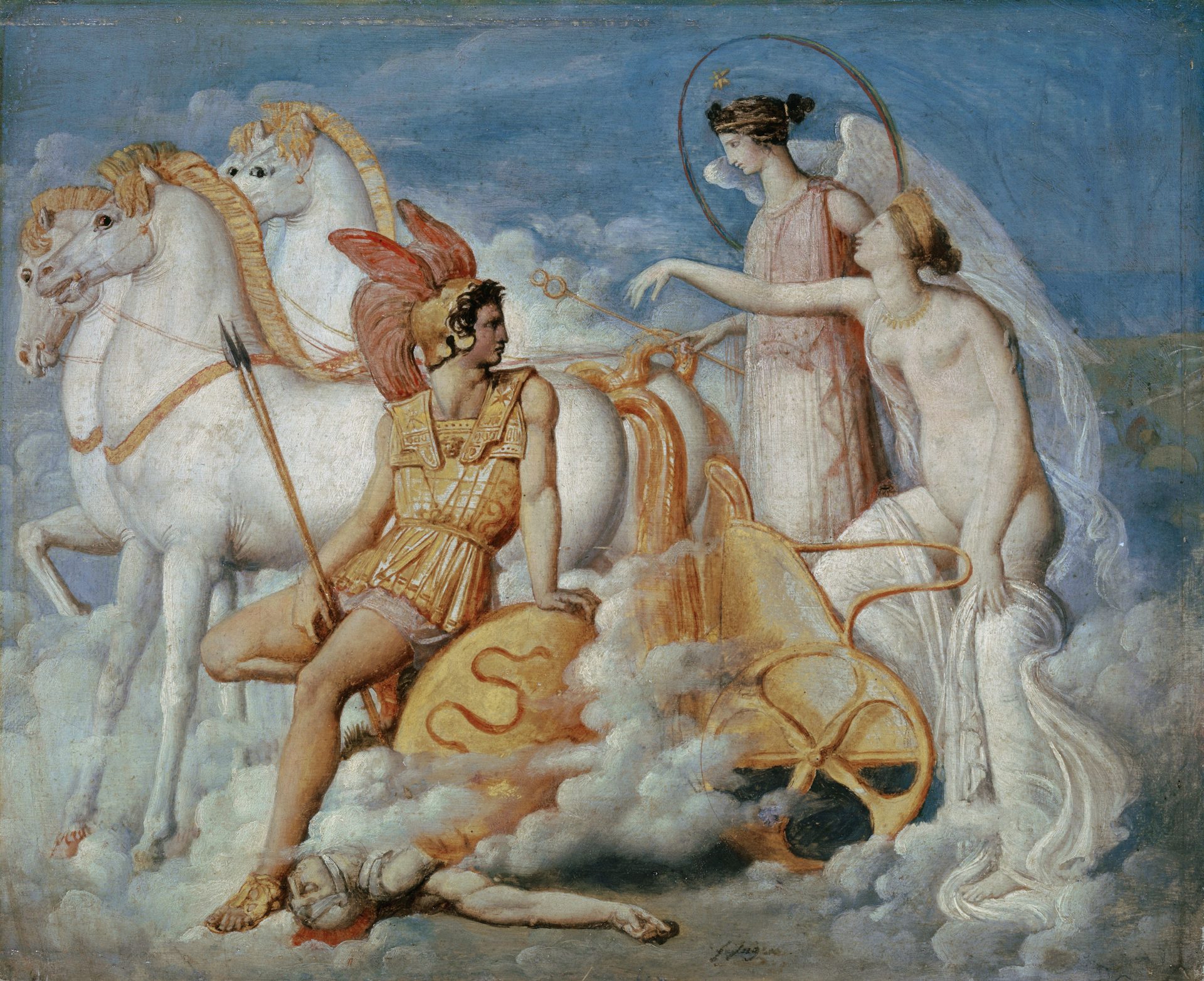Iris

Iris by John Atkinson Grimshaw (1886)
Leeds Art Gallery, LeedsPublic DomainOverview
Swift Iris, one of the children of the sea gods Thaumas and Electra, was the goddess of the rainbow. Iris was one of the divine messengers of Greek mythology, and was most commonly imagined delivering messages to gods as well as mortals. Over time, the Greeks increasingly came to think of Iris as the loyal servant of Hera, perpetually sitting at the feet of the powerful queen of the gods. In literature and in art, Iris was represented as a beautiful winged goddess, flying swiftly through the sky with her herald’s staff to carry out the tasks assigned to her by her divine patrons. Familiar though she was in ancient literature and mythological scenes, Iris seems to have been worshiped only rarely.
Etymology
The origin of the name “Iris” (Greek Ἶρις, translit. Îris) is obscure; originally, the name seems to have been Ϝἶρις (wîris). In ancient Greek, Iris’ name became the word for “rainbow.” It is possible that the name came from the Indo-European root *veh₁i-, “to bend;” but some modern scholars have argued that the name is rather of pre-Greek origin.[1]
Pronunciation
English
Greek
Iris Ἶρις (Îris) Phonetic
IPA
[AHY-ris] /ˈaɪ rɪs/
Titles and Epithets
Iris’ epithets tended to highlight her speed, which as a messenger of the gods was one of her chief attributes. Iris’ epithets thus included ὠκέα (ōkéa, “swift”), ποδήνεμος (podḗnemos, “wind-footed”), ἀελλόπος (aellópos, “storm-footed”), and ταχεῖα (tacheîa, “quick”). Iris’ shining wings also earned the goddess the epithet χρυσόπτερος (chrysópteros, “golden-winged”).
Attributes
Functions and Characteristics
Iris was the goddess of the rainbow “that the son of Cronos hath set in the clouds, a portent for mortal men.”[2] As the embodiment of the rainbow, she was described as clothed in bright colors.[3] According to one source, Iris actually used rainbows as roads to traverse the cosmos.[4] In yet another tradition, the rainbow was Iris’ belt, and was apparently sturdy enough to carry the vicious Nemean Lion down to earth from the heavens (where the creature had been conceived).[5]
Iris was also one of the chief divine messengers of the gods, alongside Hermes. In early mythological literature, Iris carried the messages of the Olympians—especially Zeus—to other gods[6] as well as to mortals.[7] But Iris could also bring messages and advice to mortals on her own initiative, typically coming disguised as a human.[8] Iris’ role as messenger took her to every corner of the cosmos, and she was known even to dive into the depths of the sea to deliver her messages.[9]
Eventually, Iris became attached to Hera, the queen of Zeus. The poet Callimachus described Iris as crouching like a hound before Hera’s throne, never sleeping or removing her belt or her shoes so that she would always be ready to carry out her orders.[10]

Juno, Iris, and Flora by François Lemoyne (1720s)
Louvre Museum, ParisPublic DomainAccording to Hesiod, Iris also had another important role: whenever one of the gods wished to swear an unbreakable oath by the Styx, it was Iris who went to fetch back some of the waters of the sacred river in order to consecrate the oath.[11]
Iris was imagined as a beautiful goddess. Though some traditions assigned her a consort and children, others described her as a virgin.[12] But perhaps the most important of Iris’ attributes was her speed. She had golden wings on which she flew through the air.[13]
Iris was a helper goddess, useful not only to the other gods but also to mortals. “Wind-footed” Iris also had some connections with the winds[14] as well as the Underworld.[15] Finally, Iris was connected to several rivers, and even gave her name to a river in northern Anatolia (the modern Yeşilırmak).[16]
Iconography
Iris was popular in ancient art, especially vase painting. In the earliest representations—such as the François Vase of ca. 570 BCE—she had winged boots and a short tunic. But later on she was more often depicted with wings growing from her back, with a long or short tunic and a herald’s staff.
In art as in literature, Iris was shown in her role as messenger or servant of the gods. She was sometimes depicted escorting the gods to ceremonial functions (such as the wedding of Peleus and Thetis). Some vases also represented her as the cupbearer of the gods.[17]

Attic red-figure stamnos attributed to the Berlin Painter (ca. 480–470 BCE) showing Zeus (center) sending out Iris (right) and Hermes (left), now in the Louvre Museum. Illustration by François Lenormant.
Gazette archéologique (1875)Public DomainFamily
Iris’ father was Thaumas, an obscure figure born from the union of the primordial gods Pontus and Gaia; her mother was Electra, one of the three thousand Oceanids.[18] The Harpies were her sisters. Some sources included the River Hydaspes in India[19] and the goddess Arce (the messenger of the Titans) as her siblings.[20]
In one tradition, Iris was the consort of Zephyrus, the god of the gentle west wind, to whom she bore either Eros or Pothos.[21]
Mythology
Iris featured in a handful of myths in the role of messenger of the gods. In one obscure tradition, Iris was already serving as the messenger of the gods during the Titanomachy, the ten-year war between the Olympians and the Titans who ruled the cosmos before then; in this tradition, Iris’ sister Arce was the messenger of the Titan opposition. When the Titans were defeated, Zeus ripped Arce’s wings from her body and gave them as a gift to the Nereid Thetis, who later gave them to her son Achilles.[22]
In other mythical accounts, Iris helped soothe Demeter in her anger over the abduction of her daughter Persephone[23] and took part in the birth of the gods Apollo and Artemis.[24]
In one story, the Boreads Calais and Zetes stopped at the kingdom of Phineus while sailing with the Argonauts, finding that the king was ceaselessly tormented by the foul Harpies. The Boreads—who could fly—resolved to help Phineus and chased the Harpies away from Phineus. But before the Boreads could kill the Harpies, Iris swooped down from the heavens to save her sisters: she warned the Boreads that it was not the gods’ will that the Harpies should die.[25]
Iris was also involved in the myths of the Trojan War from a very early period. When the beautiful Spartan queen Helen ran off with the handsome Trojan prince Paris, it was Iris who reported her departure to her husband Menelaus.[26]
According to the Iliad, Iris frequently carried messages, orders, and advice to gods and mortals during the Trojan War. On several occasions, Zeus himself sent Iris to deliver his orders to other gods or to mortals, though Iris sometimes delivered the messages of Zeus’ wife Hera or even acted independently.
In one important scene, Iris was sent to tell the Trojan king Priam to steal into the Greek camp to ask Achilles to return the body of his fallen son Hector.[27] To Priam Iris spoke in her own form and with her own voice; but the goddess usually disguised herself when she brought messages to mortals. Thus, in Book 2 of the Iliad, Iris came to Trojans in the form of the Trojan prince Polites to warn them that the Greeks were preparing for battle, and in Book 3 she came to Helen in the form of the Trojan princess Laodice to tell her that her lover Paris was fighting her husband Menelaus on the field below.[28]

Venus, Injured by Diomedes, Returns to Olympus by Jean-Auguste-Dominique Ingres (ca. 1800–1803)
Kunstmuseum Basel, BaselPublic DomainWhen she delivered messages to the gods, on the other hand, Iris usually appeared in her full glory, as when she brought to Athena and Hera Zeus’ command to refrain from helping the Greeks in battle against the Trojans.[29] In later literature, however, Iris sometimes disguised herself when speaking to the gods as well.[30]
Iris often acted on her own initiative to help gods as well as mortals. In the eventful ninth year of the Trojan War, when the Argive hero Diomedes wounded Aphrodite in battle, it was Iris who came to carry Aphrodite to safety, driving her back to Olympus in the chariot of the war god Ares.[31] Later in the war, the hero Achilles asked the winds to kindle the funeral pyre of his friend Patroclus, and Iris carried his prayers to the distant wind gods Zephyrus and Boreas.[32]
Worship
The only known cult of Iris was on “Hecate’s Island” near Delos, where worshipers made offerings of cheesecakes to her.[33]
Pop Culture
Somewhat surprisingly, Iris has been largely forgotten in contemporary pop culture: today, it is usually Hermes rather than Iris who is remembered as the messenger of the ancient Greek gods. Iris does, however, still feature in some modern adaptations of the Greek myths, such as Rick Riordan’s Percy Jackson and the Olympians series, in which she retains her role as messenger of the gods.
The name Iris is still used in scientific nomenclature. One of the asteroids of the asteroid belt, 7 Iris, takes its name from the goddess. The chemical element Iridium was also named after the goddess of the rainbow because of its colorful salts.